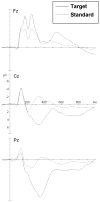Behavioural correlates of the P3b event-related potential in school-age children
- PMID: 20338199
- PMCID: PMC2866746
- DOI: 10.1016/j.ijpsycho.2010.03.005
Behavioural correlates of the P3b event-related potential in school-age children
Abstract
The latency and amplitude of the P3b component of event-related potentials (ERPs) have been related to behavioural performance on several attention and memory tasks in adult populations. However, the extent to which these results apply to children is unknown. This study examined the neurobehavioral correlates of the P3b component in a longitudinal sample of school-age children from Arctic Québec. Children (N=110; mean age=11.3years) were assessed on an ERP auditory oddball paradigm and a neurobehavioral evaluation targeting several aspects of cognition, including the Stewart Extended Continuous Performance Test (E-CPT), California Verbal Learning Test (CVLT), Stroop Color-Word Interference Test, and five subtests from the Wechsler Intelligence Scale for Children-Fourth edition (WISC-IV). P3b latency was positively related to reaction time measures and negatively associated with performance on the WISC-IV Digit Span Forward subtest. Amplitude of the P3b was associated with shorter completion time on the Stroop test and better delayed recognition memory performance among children who did not use semantic strategies on the CVLT. Profile analyses revealed no difference in scalp distribution of the P3b according to performance on these tests. The results are consistent with previous studies with older participants and suggest that, despite age-related differences in waveform and scalp distribution, the P3b component relates to similar neurocognitive processes in children and adults.
Copyright 2010 Elsevier B.V. All rights reserved.
Figures




Similar articles
-
The relation of lead neurotoxicity to the event-related potential P3b component in Inuit children from arctic Québec.Neurotoxicology. 2009 Nov;30(6):1070-7. doi: 10.1016/j.neuro.2009.06.008. Epub 2009 Jul 1. Neurotoxicology. 2009. PMID: 19576242 Free PMC article.
-
Differences in spatio‑temporal distribution of the visual P3b event-related potential between young men and women.Acta Neurobiol Exp (Wars). 2019;79(1):25-38. Acta Neurobiol Exp (Wars). 2019. PMID: 31038483
-
Some factors underlying individual differences in speech recognition on PRESTO: a first report.J Am Acad Audiol. 2013 Jul-Aug;24(7):616-34. doi: 10.3766/jaaa.24.7.10. J Am Acad Audiol. 2013. PMID: 24047949 Free PMC article.
-
Long-term neurocognitive outcome and auditory event-related potentials after complex febrile seizures in children.Epilepsy Behav. 2015 Jun;47:55-60. doi: 10.1016/j.yebeh.2015.04.067. Epub 2015 May 28. Epilepsy Behav. 2015. PMID: 26043164
-
An overview of age-related changes in the scalp distribution of P3b.Electroencephalogr Clin Neurophysiol. 1997 Nov;104(6):498-513. doi: 10.1016/s0168-5597(97)00036-1. Electroencephalogr Clin Neurophysiol. 1997. PMID: 9402892 Review.
Cited by
-
A Non-linear Relationship Between Selective Attention and Associated ERP Markers Across the Lifespan.Front Psychol. 2019 Jan 28;10:30. doi: 10.3389/fpsyg.2019.00030. eCollection 2019. Front Psychol. 2019. PMID: 30745886 Free PMC article.
-
Prenatal exposure to methylmercury and PCBs affects distinct stages of information processing: an event-related potential study with Inuit children.Neurotoxicology. 2010 Aug;31(4):373-84. doi: 10.1016/j.neuro.2010.04.005. Epub 2010 Apr 18. Neurotoxicology. 2010. PMID: 20403381 Free PMC article.
-
Children's inhibition skills are associated with their P3a latency-results from an exploratory study.Behav Brain Funct. 2022 Dec 1;18(1):13. doi: 10.1186/s12993-022-00202-7. Behav Brain Funct. 2022. PMID: 36456950 Free PMC article.
-
The P300 event related potential predicts phonological working memory skills in school-aged children.Front Psychol. 2022 Oct 12;13:918046. doi: 10.3389/fpsyg.2022.918046. eCollection 2022. Front Psychol. 2022. PMID: 36312112 Free PMC article.
-
Children with chronic lung diseases have cognitive dysfunction as assessed by event-related potential (auditory P300) and Stanford-Binet IQ (SB-IV) test.Eur Arch Otorhinolaryngol. 2016 Oct;273(10):3413-20. doi: 10.1007/s00405-016-4044-z. Epub 2016 Apr 13. Eur Arch Otorhinolaryngol. 2016. PMID: 27075686
References
-
- Barry RJ, Johnstone SJ, Clarke AR. A review of electrophysiology in attention-deficit/hyperactivity disorder: II. Event-related potentials Clin Neurophysiol. 2003;114:184–198. - PubMed
-
- Cohen J, Polich J. On the number of trials needed for P300. Int J Psychophysiol. 1997;25:249–255. - PubMed
-
- Courchesne E. Neurophysiological correlates of cognitive development: changes in long-latency event-related potentials from childhood to adulthood. Electroencephalogr Clin Neurophysiol. 1978;45:468–482. - PubMed
-
- Czernochowski D, Mecklinger A, Johansson M, Brinkmann M. Age-related differences in familiarity and recollection: ERP evidence from a recognition memory study in children and young adults. Cogn Affect Behav Neurosci. 2005;5:417–433. - PubMed
Publication types
MeSH terms
Grants and funding
LinkOut - more resources
Full Text Sources

